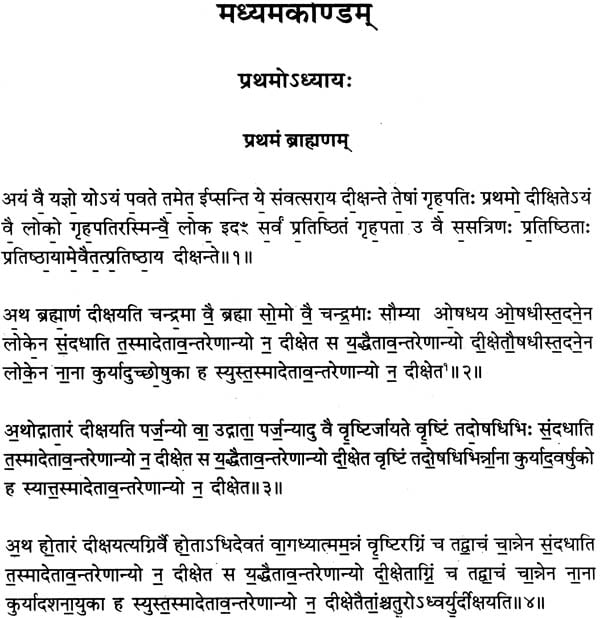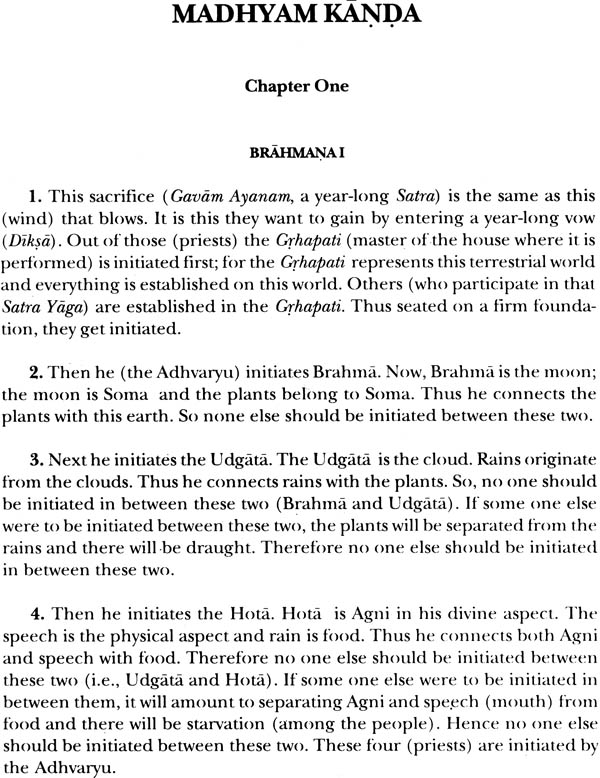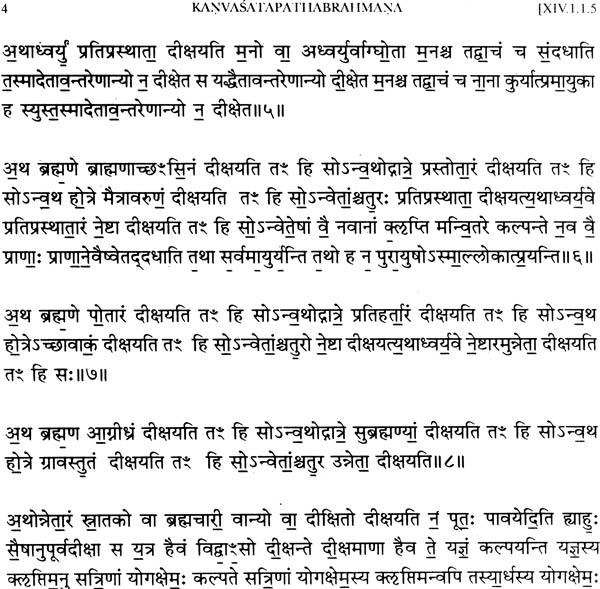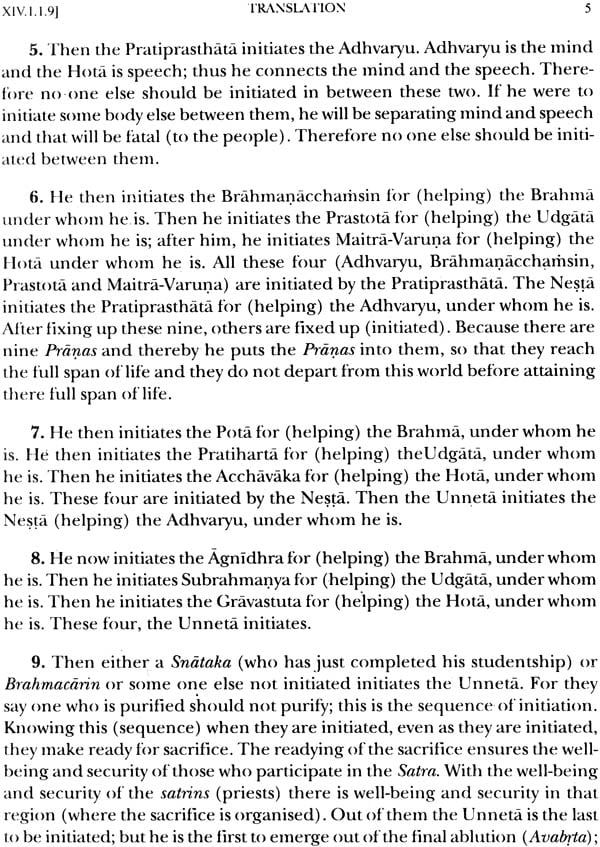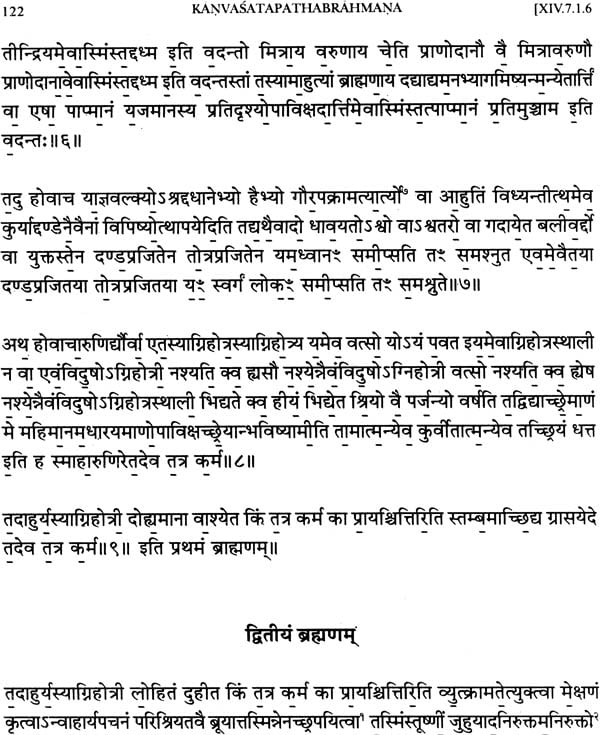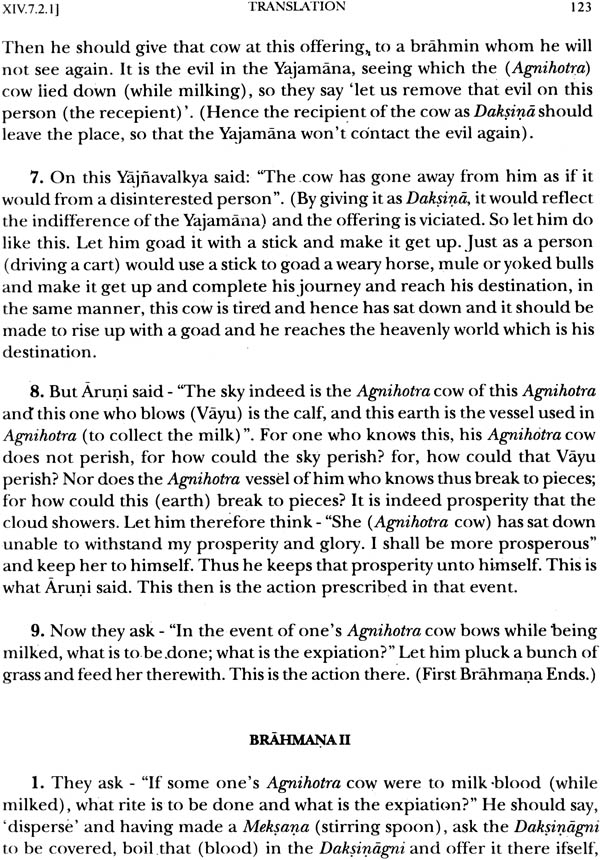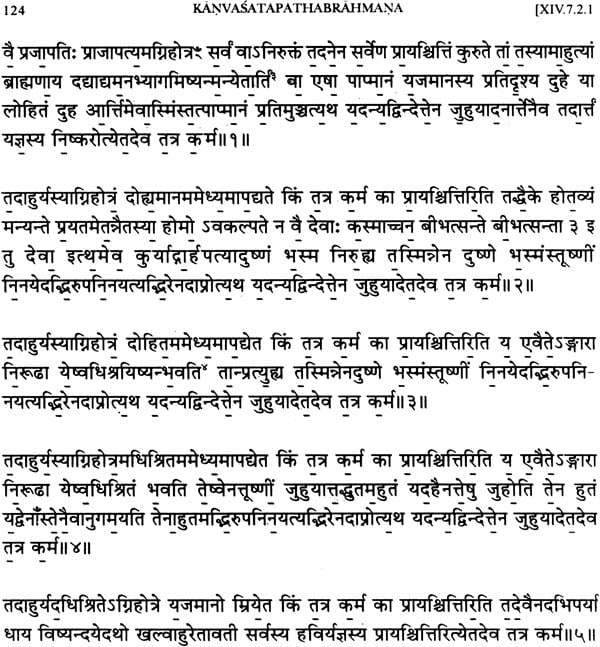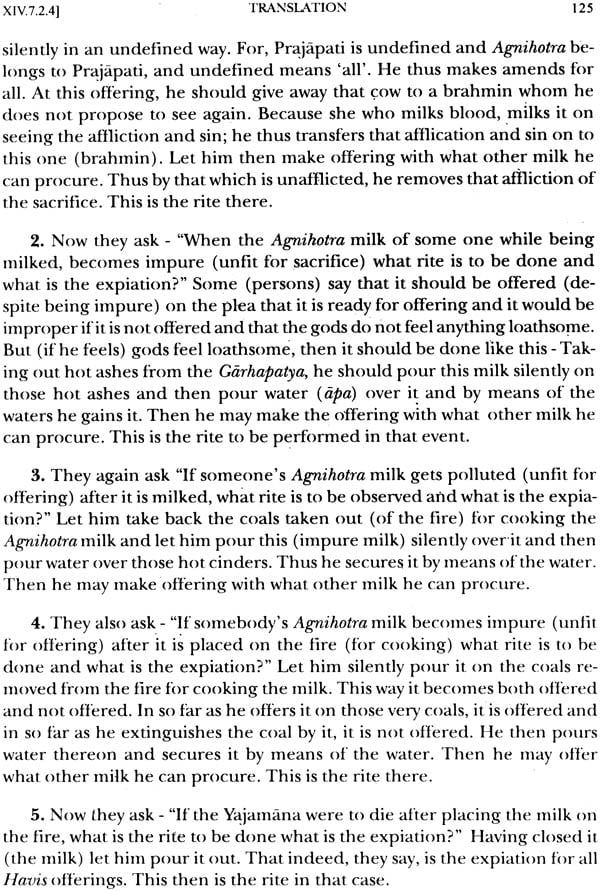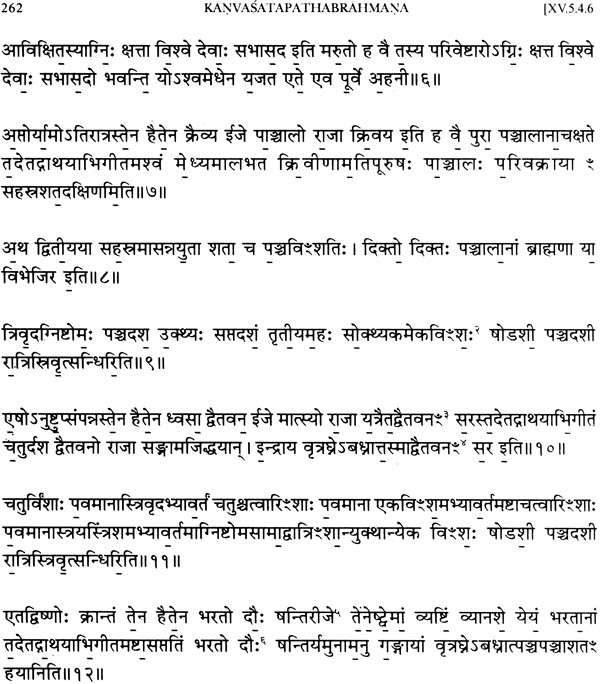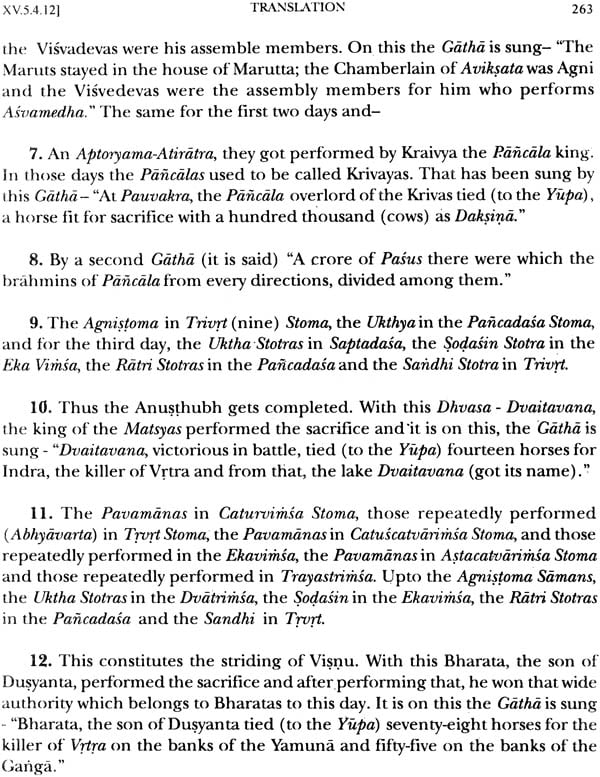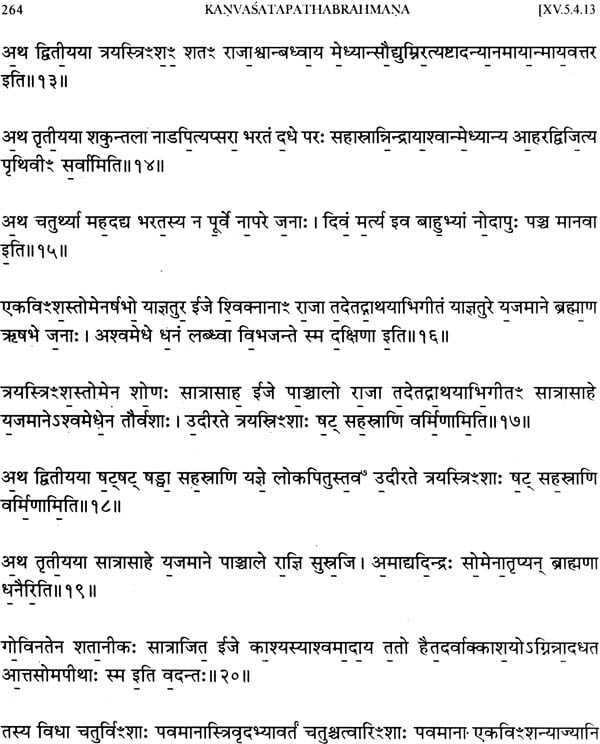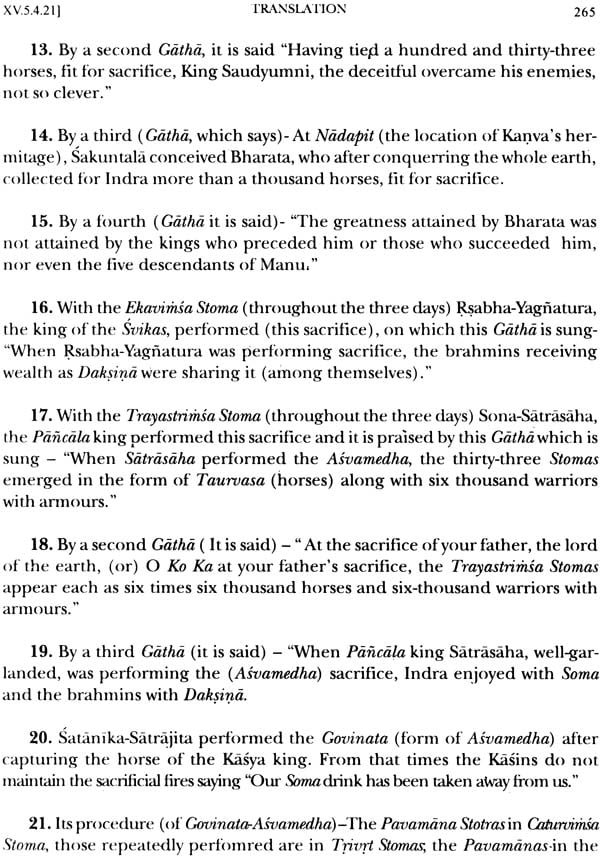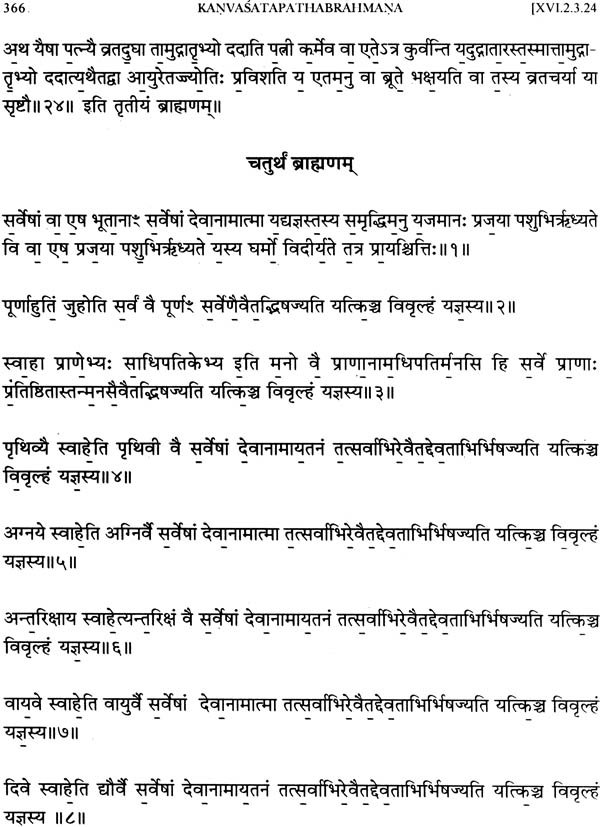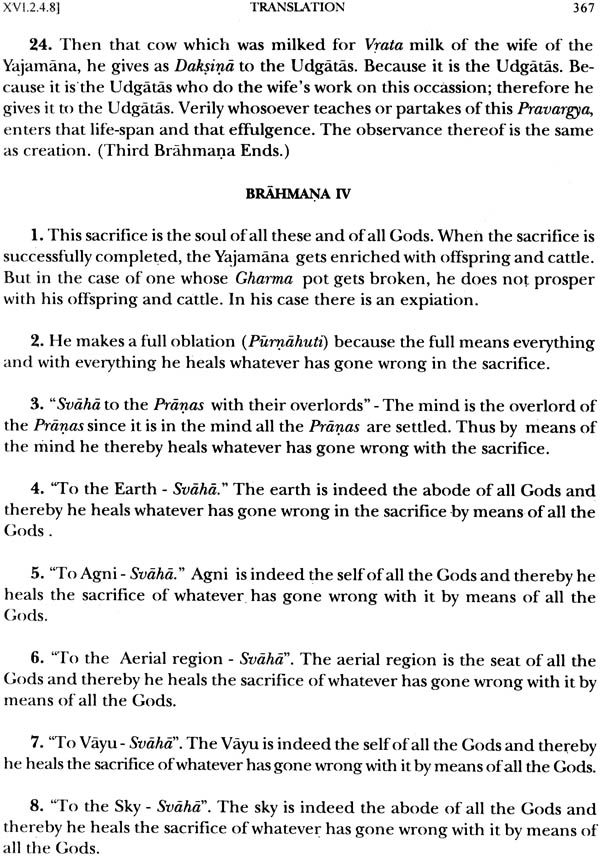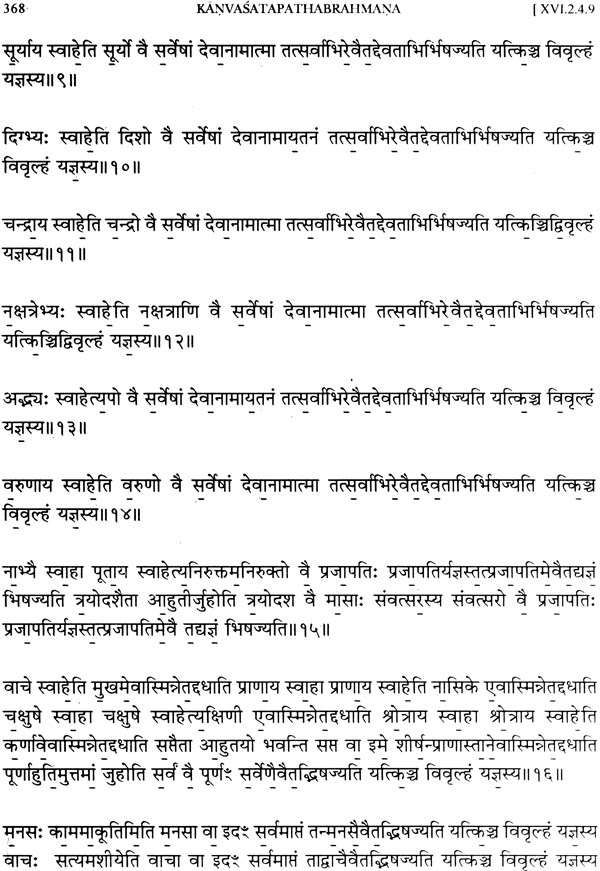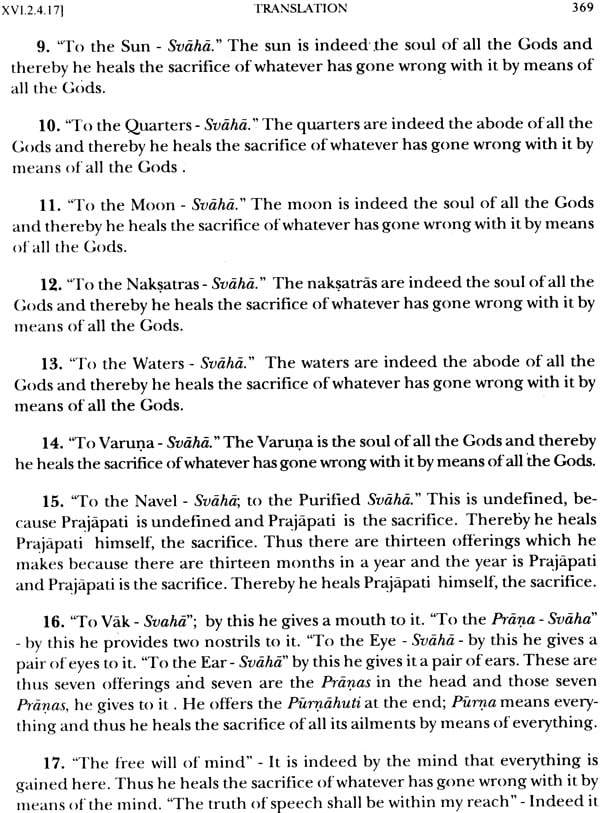
Kanvasatapathabrahmanam (Volume VII)
Book Specification
| Item Code: | NAJ983 |
| Author: | C.R. Swaminathan |
| Publisher: | Indira Gandhi National Centre for the Arts and Motilal Banarsidass Publishers Pvt. Ltd. |
| Language: | Sanskrit Text With English Translation |
| Edition: | 2015 |
| ISBN: | 9788120834958 |
| Pages: | 374 |
| Cover: | Hardcover |
| Other Details | 10.0 inch x 7.5 inch |
| Weight | 900 gm |
Book Description
It is for the first time that complete critical edition of the Satapatha-brahmana of the Kanva School of hte Sukla Yajurveda along with its English translation is published. This edition has taken into account the readings available in a few more manuscripts, besides those in the published edition in Telugu script, which were not available to Prof. Caland who brought out a critical edition of its first sevenr Kandas. It is also the first attempt at providing a complete English translation. No doubt the text of the Satapatha of the Madhyandina and Kanva School do not deffer much from kandas VIII to XVI and prof. Eggeling's translation of the former is available. The latter portion was felt necessary as a result of detailed discussions with traditional scholars who are actively engaged in Srauta sacrificial Performances.
Textual Notes to substantiate the choice of particular readings; a section under the heading Vimarsa discussing certain selected topics arising out of a study of the text; an exhaustive list of contents, Brahmanawise and Glossary of technical terms are some of the additional features of this attempt. The suggestions and guidance of traditional scholars who are experts in Srautayagas are the most important advantages of this edition.
Dr. C.R. Swaminathan hailed from an orthodox aristocratic family of Palghat, Kerala. He did his M.A. in Sanskrit in 1950 and obtained university under the able guidance of Dr. V. Raghavan; Ph. D. from Delhi University and Aharya from Darbhanga Sanskrit University.
He worked as Librarian in the oriental Manuscripts Library, Madras. He then joined Government of India in 1961 as a lecturer in Sanskrit. For a brief spell of two years he was on deputation to His Majesty's Government of Nepal as Curator, National Archives, Nepal. He retired as Deputy Educational Adviser (Sanskrit) in 1985. After his retirement he worked as Consultant in IGNCA for four Years.
As Deputy Educational Adviser he was instrumental in initiating Adarsh Sanskrit Mahavidyalaya Scheme; reprinting out of print Sanskrit works; initiating special incentives for preservation of the oral tradition of Vedic studies, and establishment of Rashtriya Veda Vidya Pratishthana – an autonomous Trust, of the Government of India. He was also credited with starting a number of Veda Pathashalas in various parts of the country.
Besides several articles and Sanskrit poetic compositions, he has quite a few publications to his credit in English and Sanskrit including his Sanskrit dissertation : A Comparative study of Gita Bhasyas Published by the Sahitya Parishad, Luckonw, which is widely acclaimed as an excellent piece of critical scholarship.
Dr. C.R. Swaminathan recived President's award for his outstanding contributions to Sanskrit Studies in the Year 1997-98. He passed away on Nov.5th 2000.
| Chapter One | 2-15 | |
| Brahmana I | Initiating priest in Gavam Ayaanam, a year – long Satra. | 2 |
| Brahmana II | Different parts of the Gavam Ayanam produced by gods. | 7 |
| Brahmana III | Prayaniya Some Krayana Atitthya offering; performing Abhiplava and Sadaha; Udayaniya three types of Mahavratas. | 7 |
| Brahmana IV | Year established in respect of the body | 12 |
| Chapter Two | 16-35 | |
| Brahmana I | Prayaniya atiratra the entry point; Visuvat an island providing with a foot – hold. | 16 |
| Brahmana II | Abhipalavas are these worlds; Prsthya is the season; twenty – one Ukthyas, whosoever knows mystic significane of the year become more prosperous. | 18 |
| Brahmana III | Year is equal to Brhati Pancavimsa is efficacious as Caturvimsa; Visuvat belongs to both preceding and succeeding (months); Dasaratra with upward tending Stoms. | 24 |
| Brahmana IV | Different parts of Purusa. | 30 |
| Chapter Three | 36-51 | |
| Brahmana I | Threefold Universe; how to perform Prayaniya Atiratra. | 36 |
| Brahmana II | Twelve pranas for the Purusa; units of time for the year. | 38 |
| Brahmana III | Inexhaustible aspect of the sacrigice; soma sava as a substitute; Tapascita for procreation of the beings | 40 |
| Brahmana IV | Narayana performed Yaga thrice; everything stands for other Vedas; 'Everything else' stands for other Pranas; everything is imperishable. | 44 |
| Brahmana V | Seizing the pasu; sitting in Samvatsara sacrifice; sacrificial rituals get merged in the Samvatsara; sacrificial rituals get merged in the Samvatsara; sequencial balance of Samvatsara. | 46 |
| Chapter Four | 52-69 | |
| Brahmana I | Tvasta performed Abhicara on Indra; Asvins and Sarasvati saved Indra from affliction | 52 |
| Brahmana II | Soma is the food of brahana; Asvins are the physicians of gods; Sarasvati is the medicine; Indra stands for vitality or strength; Sautramani is both an 1sti and a pasubandha; Purodasa for different deities. | 56 |
| Brahmana III | Indra's strength carried away by Namuci; two vedis for the workd of Pitrs on who perform the Sautramani lives his full – span of life. | 62 |
| Chapter Five | 70-99 | |
| Brahmana I | Offering Grahas of mild into the northern fire; offering fourteen Grahas of Sura into the Southern fire; Svadha by means of prostrations; sautramani is purificatory. | 70 |
| Brahmana II | Prajapati performed some sacrifice; morning is the terrestrial world; sautramani organised by asvins, Sarasvati and Indra. | 78 |
| Brahmana III | Indra desecrated the sacrifice and wandered in all directions; Asvins and Sarasvati organised Sautramani sacrifice for Indra; one who is consecrated by sautramani becomes the ruling power; rubbing of sacrifice with fragrant substances; Svistakrt offerings | 88 |
| Chapter six | 100-117 | |
| Brahmana I | Sautramani is performed by means of Parisrul Sautramani is Brahmin's sacrifice; three Purodasa; life of man is divided into three stages; life – apan gained by performing Sautramani; combining the deities together. | 100 |
| Brahmana II | Sautramani is Soma sacrifice; placing the samidha in the Ahavaniya; preparation of caru for Aditi. | 106 |
| Brahmana III | Dusraritu Paumsayana was banished from kingdom; Sura (liquor) should not be offered in the Ahavaniya fire; who know the Prnita aspect of the Pranita waters gets well established; Prayaja offerings; Ahavaniya is the womb of the gods; payograhas are offered | 110 |
| Chapter Seven | 118-139 | |
| Brahmana I | Agnihotra is a Satra; Garhapatya is terrestrial world; Visnu took stride uttering the Rk Mantra; Aditi bestowed life upon the master of the sacrifice. | 118 |
| Brahmana II | Rite for Agnihotra cow who milked blood; rite for impure milk; expiation for all Havis offerings Agnihotra milk taken in the sruk | 122 |
| Brahmana III | Expiation for the fire getting extinguished; fire in every piece of wood; recitation of seventeen Samidheni mantras, Agnihotra winner of heaven; two Ajyabhagas related to the killer of Vrtra; the two Samyajyas in the Virad metre; yajya and Puronuvakya | 128 |
| Brahmana IV | Rite for someone's fire to get mixed up chanting of two Yajyas and Anuvakyas, preparation of Purodasa in eight potsherds for Agni; rite for fire which is burnt by lightening. | 132 |
| Chapter Eight | 140-149 | |
| Brahmana I | Offering of Soma to deities; inclinations of sacrifice to different deities; thirty four oblations. | 140 |
| Chapter Nine | 150-161 | |
| Brahmana I | Agnihotra oblation; fire longs for sacrificial oblations; transferring fires on Aranis; Kusas or Darbhas are made to point to the South; placing the bone in a black antelop's skin and arranging them in the shape of man. | 150 |
| Brahmana II | Transferring Yajamana's fire on two Arnis; building an altar in between the fires; follower of progeny will be the foremost in this world. | 154 |
| | ||
| Chapter One | 162-179 | |
| Brahmana I | Adhvaryu cooks Brahmaudana; rope made up of Darbha Grass; Prajapati created sacrifice. | 162 |
| Brahmana II | Yajus formula for the success of sacrifice; conquering all quarters by performing Asvamedha; Prajapati most vigorous among the gods; all gods associated with the Asvamedha. | 163 |
| Brahmana III | Stokya offerings; Rupa offerings forms of the horse; offering of oblations for continuity and uninterrupted completion of sacrifice. | 166 |
| Brahmana IV | Prajapati created Asvamedha Istis for Savita Dhrti offerings. | 168 |
| Brahmana V | Lute symbolises prosperity pristhood and royality fulfilment of wishes is in the control of priest - hood and strength is endowed through ksatra. | 170 |
| Brahmana VI | horse overtake all other animals, Dhrti oblations for a years Asvamedha means sovereignty. | 172 |
| Brahmana VII | Diksa securd for Yajamana Audgrabhana offerings Vaisvadeva offernings. | 174 |
| Brahmana VIII | Vaisvadeva offering for sustaining the Asvamedha. | 176 |
| Brahmana IX | Brahmavarcas upon the priestly class; bestowing the glory of heroism on Prince; bestowing velour in the Yajamana's progeny. | 178 |
| Chapter Two | 18-202 | |
| Brahmana I | Anna – homas for pleasing the gods; offerings with ghee, saktu grains and with parched grains. | 180 |
| Brahmana II | Asvamedha the king of sacrifices fifteen Paryangya Pasus; appeasing with Barhadukta mantras; Vis enriched with peasantry. | 182 |
| Brahmana III | Pavamana (Soma or the Stotra); Udgitha Saman. | 186 |
| Brahmana IV | Prajapati desires to gain the world of Gods and the world of men. | 186 |
| Brahmana V | Horse sap created by Prajapati eleven sets of Yupas; Trsthubh is essence; Jagati symbolises cattles; Hota and Brahma engaged in Brahmodaya. | 188 |
| Brahmana VI | Putting horse to chariot; one who sings praise is Vayu; trsthubh is essence; Jagati symbolises cattles; Hota and Brahma engaged in Brahmodaya. | 190 |
| Brahmana VII | Chanting of Yajus formula; prostration to Agni; chariot with decorating cords. | 194 |
| Brahmana VIII | Gods proceeded upwards with horse to know to the heaven; impregnation means offspring and cattle. | 198 |
| Brahmana IX | Prosperity is weight of the royal power; who speaks impure speech at the sacrifice Pranas depart from him. | 200 |
| Brahmana X | Yajamana builds a cause – way to cross over to the heavely world. | 202 |
| Brahmana XI | Desire of Prajapati to become great and multiple. | 203 |
| Chapter Three | 204-219 | |
| Brahmana I | Asvamedha – an expiation – an antidote for everything; Catustoma form/method of chanting; Atiratra with all the Stomas. | 204 |
| Brahmana II | Ekavimsa (the Sun) – a firm foundation; Prstha – Stotras, different metre for each Stotra; Visvedevas – for the sake of completeness. | 204 |
| Brahmana III | Anusthubh is the super – most among the meters; horse is super – most among the Pasus, Sakvari Chants form the Prstha Vamadevya Saman sung for the Maitravaruna; Brahma saman is the Parthaurasma Saman; Samkrti Saman is the Saman of the Acchavaka. | 206 |
| Brahmana IV | Twenty – one – fold fire – altar; twenty – one – fold is the head of the sacrifice. | 208 |
| Brahmana V | The Aranye – Anucya offerings; last offerings to haven and earth; Svistakrts – to overcome the enemy. | 210 |
| Brahmana VI | Offering of oblations to Mrtyu. | 212 |
| Brahmana VII | Asvastomiya oblations; Brahmaudana for the priests. | 212 |
| Brahmana VIII | Various types of sacrifice. | 214 |
| Brahmana IX | Prana transforms the seed ; Pusa is the lord of the cattle purodasa to Vaisvanara in twelve potsherd; barley belongs to Varuna; performance of list with Havis. | 216 |
| Chapter Four | 220-243 | |
| Brahmana I | All desires and excellence can be achieved by performing Asvamedha prepared by Adhvaryu ; Pathikrt Isti to Agni for gaining the path; pusa is the overlord of the paths; Anustubh is speech and speech | 220 |
| Brahmana II | Fifteen Samidheni chants and two Ajyabhagas to the killer of Vrtra; Svistakrt offering in virad metre; trsthubh chants symbolise vitality in Indra. | 226 |
| Brahmana III | Pariplava legend Prakrama oblations; recitation of Yajus Anuvaka; recitation of Sarpavidya chapter; Brhati metre consists of thirty – six syllables. | 232 |
| Brahmana IV | Grining royal power by means of thunderbolt; descriptions of Yupa; ritual of the first Sutya. | 238 |
| Chapter Five | 244-269 | |
| Brahmana I | Chanting of Sroma of Gotama; twenty – one Savaniya pasus on the Sutya days; Ekavimsa is the base of Stomas; constituents of morning savana. | 244 |
| Brahmana II | Fifteenfold thunderbolt; Advaryu addresses the horse and young lass; Brahma addresses the queen; Udgata addresses the favourite wife; Brahmodaya marks the complete attainment of speech. | 250 |
| Brahmana III | Offering of Vapas,Bahispavamana in Trivrt; twenty – one Savaniya Pasus. | 256 |
| Brahmana IV | One who performs Asvamedha puts an end to all evil acts; Agnistoma in Trivrt; Ukthya in the Pancadasa stoma procedure of Govinata – Asvamedha, Udayaniya offering. | 260 |
| Chapter Six | 270-279 | |
| Brahmana I | Desire of Purusa Narayana; twenty – three Diksas; eleven yupas; Purusamedha is everything. | 270 |
| Brahmana II | Purusas are symbolically immolated; Brahman is the supermost in universe; offering with ghee; ghee is effulgence. | 274 |
| Chapter Seven | 280-285 | |
| Brahmana I | Brahman underwent tapas, Sarvamedha is the super – most among the yajna – kratus, by performing sarvamedha one can surpass all beings and become everything here. | 280 |
| Chapter Eight | 286-303 | |
| Brahmana I | Preparation of Smasana – an eternal resting place for the body of Yajamana. | 286 |
| Brahmana II | Procedures for an Agnicit; difference between the acts of gods an those of Pitrs. | 290 |
| Brahmana III | Sowing the seeds of all herds; Placing of thirteen bricks. | 294 |
| Brahmana IV | Palasa represents the Brahmin; objects of make – up for humans; prescribed Daksina. | 298 |
| Pravargya kanda – XVI | ||
| Chapter One | 304-335 | |
| Brahmana I | Sacrificial session performed by the gods at Kuruksetra Visnu's body divided between the gods; Rule of abstinence observed while teaching the Pravargya | 304 |
| Brahmana II | Collecting of materials for preparing Maha Vira pot; making of Maha vira vessels in shed; fumigating and baking of the vessels; maha Vira vessel polished with Gavedhukha grass; fire enables all creatures to exist in this world; preparation of pravargya is | 310 |
| Brahmana III | Kusa grass is spread infront of the Garhapatya fire recitation of prasise by hota; some is king whereas Pravargya is Emperor; Savita is the impeller of the Gods; Indra himself the overlord to destroy the Raksasas. Pitrs are three in number. | 320 |
| Brahmana IV | Avakasas are the Pranas, vital aris are six in number three Avakasaverses recitation of Bhramana passage by Dadjyang atharvana . | 330 |
| Chapter Two | 336-373 | |
| Brahmana I | Offering of two Rauhina Purodasas cow is Ida; Aditi and Sarasvati; flowing down milk in milking bowl for Asvins, Sarasvati and Indra; Indra is deity of sacrifice; Asvins restore the head of sacrifice; placing of pravargya on the Upayamani. | 336 |
| Brahmana II | Adhvaryu makes the offering by chanting the name of Vayu; morning Savana and midday Savana, twelve names of Vayu; Gharma to Pitrs consecration formula announced by Brahma offering with cut pieces of Vikankata wood; seven offerings corresponding to the sev | 342 |
| Brahmana III | Combining of Pravagya and Upasad Performances conducting the Utsadana o Pravargya samans are dispellers of terrible Raksasas, Marjaliya is resting place; sprinkling of Pravargya material with water, varsahara Saman sung by Orastota midday pavamana is the | 356 |
| Brahmana IV | Sacrifice is the soul of all things and all Gods; Purnahuti for healing whatever has gone wrong in the sacrifice; Pravargya is everything. | 366 |
